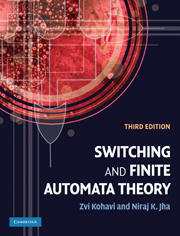Book contents
- Frontmatter
- Contents
- Preface
- Part 1 Preliminaries
- Part 2 Combinational logic
- Part 3 Finite-state machines
- 9 Introduction to synchronous sequential circuits and iterative networks
- 10 Capabilities, minimization, and transformation of sequential machines
- 11 Asynchronous sequential circuits
- 12 Structure of sequential machines
- 13 State-identification experiments and testing of sequential circuits
- 14 Memory, definiteness, and information losslessness of finite automata
- 15 Linear sequential machines
- 16 Finite-state recognizers
- Index
14 - Memory, definiteness, and information losslessness of finite automata
from Part 3 - Finite-state machines
Published online by Cambridge University Press: 05 June 2012
- Frontmatter
- Contents
- Preface
- Part 1 Preliminaries
- Part 2 Combinational logic
- Part 3 Finite-state machines
- 9 Introduction to synchronous sequential circuits and iterative networks
- 10 Capabilities, minimization, and transformation of sequential machines
- 11 Asynchronous sequential circuits
- 12 Structure of sequential machines
- 13 State-identification experiments and testing of sequential circuits
- 14 Memory, definiteness, and information losslessness of finite automata
- 15 Linear sequential machines
- 16 Finite-state recognizers
- Index
Summary
An important characteristic of a finite-state machine is that it has a “memory,” i.e., the behavior of the machine is dependent upon its past history. While the behavior of some machines depends on remote history, the behavior of others depends only on more recent events. The amount of past input and output information needed to determine the machine's future behavior is called the memory span of the machine.
If the initial state of a deterministic completely specified machine and the input sequence to it are known then the corresponding final state and output sequence can be determined uniquely. However, there are special situations in which either the initial state is unknown or some past input symbols are unknown. In such situations, the behavior of the machines cannot always be predicted in advance. In this chapter, we shall try to answer the following questions. For a given machine, what is the minimum amount of past input–output information required in order to render its future behavior completely predictable? Under what conditions can the input sequence to the machine be reconstructed from its output sequence? Finally, we shall investigate some aspects of the relationship between finite-state machines and coding theory.
Memory span with respect to input–output sequences (finite-memory machines)
A finite-state machine M is defined as a finite-memory machine of order µ, if µ is the least integer such that the present state of M can be determined uniquely from the knowledge of the last µ input symbols and the corresponding µ output symbols.
- Type
- Chapter
- Information
- Switching and Finite Automata Theory , pp. 478 - 522Publisher: Cambridge University PressPrint publication year: 2009

